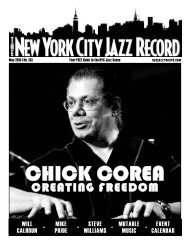You also want an ePaper? Increase the reach of your titles
YUMPU automatically turns print PDFs into web optimized ePapers that Google loves.
22 May 2013 | THE NEW YORK CITY JAZZ RECORD<br />
Eponymous<br />
Federico Ughi Quartet (FMR)<br />
by Marc Medwin<br />
Given the diversity of this group’s collective<br />
background, the many nods toward tradition are<br />
almost surprising. It isn’t that drummer Federico Ughi,<br />
altoist David Schnug, cornetist Kirk Knuffke and<br />
bassist Max Johnson aren’t steeped in the jazz tradition;<br />
their credentials are well established and they have<br />
developed long-standing collaborative projects in<br />
various formations and contexts in and around jazz.<br />
The fact is, however, that they also embrace many<br />
others, from bluegrass to art rock and much in between,<br />
though subtlety of form and reference seems to be the<br />
path trod on every track of this quartet’s debut.<br />
The most overtly non-’jazz’ offering here is<br />
“Wearing a Wire?”, with its smart and soulfully driven<br />
rhythms, courtesy of Ughi, supporting a heavily<br />
accented unison melody. Knuffke’s solo gradually<br />
morphs from blues to something on the order of<br />
Plugged Nickel-era Miles as the others weave in and<br />
out of funk and noisy free jazz modes. Frequent pauses<br />
and tempo shifts only add to the track’s in-your-face<br />
intrigue, conjuring shades of Ornette Coleman’s later<br />
projects in the process.<br />
The rest of the album draws on Coleman’s work as<br />
well, particularly the jaunty “Technicolor”, sounding<br />
as if it was pulled from one of the Sound Museum<br />
discs, but, of course, none of the music adheres so<br />
strictly to form and structure. The labyrinthine<br />
melodies and drones of “Ange” are closer to the New<br />
York Art Quartet’s brand of musical cinematography<br />
than to anything Coleman waxed as Ughi supports the<br />
constantly shifting structures with expert brushwork.<br />
If one aspect of the disc could be changed, it is the<br />
almost incessant reliance on unisons. On future efforts,<br />
the group would do well to skip right to the bluesy or<br />
pointillistic bits, saving unison passages for special<br />
occasions. That said, these ten compositions,<br />
augmented by Ughi’s polyrhythmic and timbral<br />
facility, Schnug’s unpretentious growls, Knuffke’s<br />
smooth warm tones and Johnson’s flawless arco, add<br />
up to make an excellent first effort.<br />
For more information, visit fmr-records.com. Ughi is at<br />
Ibeam Brooklyn May 18th and 24th with this project. See<br />
Calendar.<br />
Audacity<br />
George Garzone/Frank Tiberi (Stunt/Sundance)<br />
by Stanley Zappa<br />
While there is nothing at all audacious about Audacity,<br />
what’s not to like about saxophonists George Garzone<br />
and Frank Tiberi weaving predictably crafty, intricate<br />
lines atop a rhythm section that never really exceeds<br />
the Jamey Aebersold play-along threshold of rhythm<br />
section persuasion? Should the recording sound stiff,<br />
drummer Jakob Hoyer, though not the solution, is not<br />
the problem. Rasmus Ehlers’ piano solos make one<br />
wonder what happened to his left arm. On “Two<br />
Brothers”, the effect is memorable, like meeting<br />
someone really hot who for some reason doesn’t have<br />
a nose. By “Solar” (track 6), all hotness has been<br />
eclipsed by the harmonic noselessness. Jonas<br />
Westergaard’s bass is unwavering, unflappable and, at<br />
the same time, unremarkable. Fortunately, this is not a<br />
problem in light of the more pressing agenda of<br />
presenting two acknowledged, well ensconced,<br />
thoroughly documented masters once again romping<br />
through the tropes and paying homage to John Coltrane<br />
46 years after his death, at this juncture in their long<br />
and storied careers, in the year of our lord 2013.<br />
“My father died...I was left to support the family<br />
and at 13 I had gigs three nights a week,” says Tiberi<br />
(born 1928) in the liner notes to Audacity. If social<br />
conditions have any effect on one’s musicality, there<br />
won’t be too many Frank Tiberis making their version<br />
of Audacity in the year 2080. His sound, vocabulary<br />
and phrasing come from social realities and economic<br />
conditions long gone. Tiberi’s composition “My Man“<br />
and his solo therein is why he is to be treasured.<br />
Though younger, Garzone also enjoyed that<br />
commercially archetypal time in improvised music so<br />
deftly commodified by the participants. Garzone has<br />
the value add of a career in academia, which he<br />
capitalizes on throughout the recording; those aesthetic<br />
dividends contribute significantly to Audacity’s net<br />
worth. That said, everyone would be the poorer were<br />
Audacity the only recorded statement for anyone<br />
involved.<br />
For more information, visit sundance.dk. Garzone is at The<br />
Stone May 19th with Uri Gurvich and ShapeShifter Lab<br />
May 25th. See Calendar.



